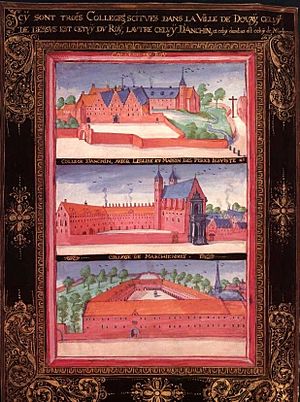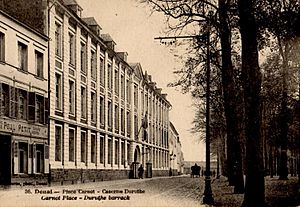English College, Douai facts for kids
|
Collège anglais de Douai
|
|
| Latin: Collegium Anglorum Duacense | |
| Type | Seminary |
|---|---|
| Active | 1568–1793 |
|
Parent institution
|
University of Douai |
| Affiliation | Roman Catholic |
| Location |
,
France
|
| Language | English |
The English College was a special school in Douai, France. It was a seminary, which is a place where people train to become Catholic priests. The college was connected to the University of Douai.
It started in 1568 and closed in 1793 during the French Revolution. The college is famous for helping to translate the Bible into English, which is known as the Douay–Rheims Bible.
Many priests from this college went on special missions to England. About one-third of them faced serious danger or even lost their lives because being a Catholic priest was against the law in England at that time. When the college closed, it led to the creation of two new colleges in England: Crook Hall (which later became Ushaw College) and St Edmund's College, Ware.
Some people believe that money meant to help the college after it closed was instead used to finish decorating George IV's fancy Brighton Pavilion in England.
Contents
History of the College
The English College was part of a larger university in Douai, France. This university was very important in its time.
The University of Douai
Philip II of Spain started the University of Douai between 1560 and 1562. It was a sister university to one in Louvain. The university was strongly Catholic and had five main subjects: theology, law, medicine, and arts.
In its early years, many English professors taught there. These professors had left the University of Oxford in England when Protestantism became the main religion. William Allen, from England, became a professor of divinity there.
Starting an English College
Many English Catholics lived in Douai because Elizabeth I had become Queen of England and brought back Protestantism. William Allen had the idea to create a seminary just for English Catholic priests. He wanted their studies to be linked to the university.
Allen rented a house in Douai in 1568 with six students. Soon, similar colleges were set up in Douai for Scottish and Irish Catholic priests. There were also houses for Benedictine, Franciscan, and Jesuit religious orders.
Allen wanted to bring together English Catholics living in other countries. He hoped to train them to become priests who could help England return to Catholicism. The college was also one of the first seminaries approved by the Council of Trent, a major meeting of the Catholic Church. Philip II of Spain supported the college with money each year. Other English colleges were later started in Rome, Spain, and Portugal.
At first, the college didn't have a regular income. It relied on gifts from England and local friends. William Allen even gave his own salary to keep the college going. Later, Pope Gregory XIII gave the college a regular monthly payment.
Allen's leadership attracted over 150 students within a few years. The famous Douay–Rheims Bible was finished at this college in 1609. However, the college faced some problems and had to move temporarily to Rheims in 1578. They returned to Douai in 1593.
The Douai Martyrs
When England did not return to Catholicism as expected, the college began sending trained priests back to England. These "missionary priests" secretly helped Catholics and tried to bring people back to the Catholic faith.
Being a Catholic priest in England at that time was considered a serious crime. Of the over 300 priests sent from Douai by the end of the 1500s, more than 130 lost their lives. Many others were imprisoned or sent back to Europe. In 1577, Cuthbert Mayne was the first Douai priest to be executed. Back in Douai, the college held a special church service each time they heard news of another priest being executed.
Later Years of the College
Under Dr. Richard Barrett, the college also started offering a preparatory course for younger students. In 1603, a new college building was constructed.
The college faced some disagreements between different groups of priests. However, leaders like Matthew Kellison helped improve the college's reputation.
In the late 1600s and early 1700s, the English College had a difficult time. There were disputes with the University of Douai and accusations against some professors. Despite these challenges, the college continued its work.
The college became even more important to English Catholics after their hopes of England returning to Catholicism ended. Under Dr. Robert Witham, the English College at Douai was rebuilt. It also recovered from losing much of its money in a financial crisis known as the "South Sea Bubble".
The French Revolution
During the French Revolution, the town of Douai faced many changes. In 1791, all clergy were asked to take a "Civic Oath" to the new government. The English members of the college said they didn't have to because they were not French citizens.
This was allowed for a while. But when Louis XVI was executed and Britain declared war on France, many British students and leaders left for England. The members of the English College, led by Rev. John Daniel, stayed hoping to save the college.
However, in October 1793, they were all taken to prison. After suffering in prison, they were allowed to return to Douai in November 1794. A few months later, they were given permission to go back to England. The college never returned to Douai.
In England, laws against Catholics had recently been changed. The former students and staff founded two new colleges to continue the work: Crook Hall (later Ushaw College) in the North and St Edmund's College, Ware in the South.
After the English students left in 1793, the college building became military barracks. It was torn down in 1926. Later, during digging, old items were found, including the body of Father John Southworth, a former student who had been executed for his faith.
After the Revolution, a large sum of money was paid to the British government to help those who had suffered. However, none of this money reached the Catholic colleges. It was decided that because the Catholic colleges were in France because they were illegal in England, they were considered French, not English.
An old story says that the money was instead used to finish decorating George IV's Royal Pavilion in Brighton.
Present-day College Site
Today, the buildings where the English College once stood are home to the Institution Saint-Jean de Douai. This is a school for children in Douai.
See also
- List of presidents of the English College, Douai
- Irish College, Douai
- Scottish College, Douai
- English College, Valladolid
Images for kids
de:Englisches Kolleg




